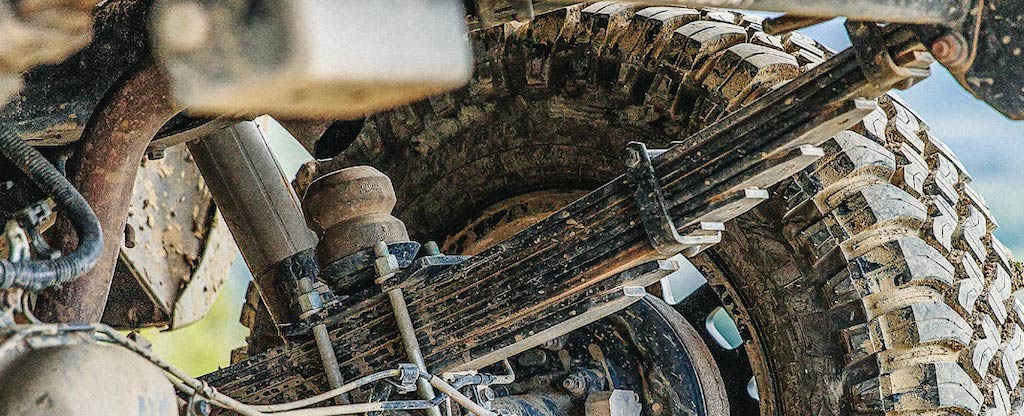
Ever since the invention of the horseless carriage, rubber has been used in whole or in part as a design element for suspensions. As technology continued to advance, suspension design evolved giving the consumer more alternatives.
After many years of continuous experimentation, the dedicated people at Timbren have gained – through practical experience – a thorough understanding of the dynamic characteristics and properties of rubber.
By answering the following questions, this article will explain the benefits of rubber springs, and how you can benefit from their use.
- What are rubber springs?
- What are the advantages of rubber springs?
- Rubber springs vs metal springs: How do they compare?
- How do I choose the right rubber springs for?
- How do I install rubber springs?
- How much are rubber springs?

What are rubber springs?
Aeon® rubber springs are made of natural rubber and are designed as an alternative to metal. Rubber molding is a method of adding heat and pressure to uncured rubber to produce useful products such as rubber springs.
There are 5 elements to the rubber molding process:
- Heat
- Pressure
- Uncured rubber
- Mold
- Cure time
Heat and pressure force the uncured rubber into the mold to make it conform to a specific size and shape. The newly formed rubber spring must remain in the heated press for a certain length of time for it to cure. The curing of rubber is a process called vulcanization.
Rubber springs have multiple uses and therefore come in different lift heights, sizes, and shapes. Additionally, they come in different durometers (hardness) of rubber.

What are the advantages of rubber springs?
The characteristics inherent in springs made from natural rubber give them an advantage over more conventional springs.
Self-damping properties
Aeon® rubber springs possess a unique quality called “hysteresis.” Simply put, they act as a shock absorber. They’re particularly effective when used as a helper spring.
Variable spring rate
Because they’re made from natural rubber, Aeon springs have an advantage over steel springs: The ability to increase their spring rate as the load increases.
Space-saving
Rubber springs can be used for various purposes, particularly when space is limited.
Vibration damping & noise reduction
Rubber springs work quietly, isolating the vibration on a piece of machinery. This makes them useful in various industries, such as Automotive, Mining, Forestry, and Agriculture.
Road-shock absorption
When used as a helper spring on a vehicle’s suspension, they smooth out the ride by absorbing road shock.

Rubber springs vs metal springs: How do they compare?
If we were to compare rubber springs to metal springs, there would be some obvious differences and few similarities, particularly when comparing their use as helper springs.
Progressive spring rate vs linear spring rate
Aeon® hollow rubber springs have some unique characteristics. One of them is a progressive spring rate. As the load increases, the rubber springs will push back even harder. This allows them to keep the vehicle level even under the heaviest loads.
Metal (steel) springs, like leaf and coil, have a more linear spring rate. In other words, the spring rate does not increase as the load increases. Therefore, a steel spring will bottom out long before a rubber spring. This is why rubber springs are considered stronger than steel.
Self-damping vs assisted damping
Hollow rubber springs are self-damping. In other words, they control their rebound. That’s because of a little thing called “hysteresis.”
Metal springs, on the other hand, require shock absorbers to control the bounce and smooth out the ride. Without a shock absorber, the body of the vehicle would bounce too much, ruining ride quality.

How do I choose the right rubber springs?
Vibration control
Timbren Industries has the largest selection of Aeon® hollow rubber springs of any manufacturer. Each Aeon® part number is listed on the Timbren website according to height, width, shape, nominal capacity (working capacity), bump load capacity, nominal height, maximum deflected height, and maximum diameter. Contact Timbren for a suitable part number for your application.
Helper springs
Timbren Industries has over 450 SES (Suspension Enhancement System) upgrades made to fit most truck makes and models. SES kit capacities range anywhere from 600 lbs. up to 64,000 lbs. Every part number is a perfect combination of Aeon® rubber springs, metal brackets, and fasteners that make the installation simple and easy. Contact Timbren to order the correct part number suitable for your application.
Bump stops
Timbren Industries now offers Active Off-road Bump Stops for over 25 different off-road applications. These off-road bump stops install the same way as their SES counterparts. Active Off-Road Bumpstops are designed to soften axle engagement, increase overall control, and reduce the stress on both vehicle and driver, allowing you more time out on the trails.

How do I install rubber springs?
If you plan to buy Aeon® hollow rubber springs individually, you can get recommended installation instructions by contacting Timbren Industries: sales@timbren.com
If you plan to buy an SES product, installation instructions are included with your purchase. Most of the time, the SES product replaces a factory bump stops.

How much are rubber springs?
Individual Aeon® springs
There are about 34 different Aeon® part numbers to choose from. Prices for one unit range anywhere from $42 US to $1400 US.
SES kits
There are approximately 450 SES part numbers that include Aeon® springs, brackets, spacers, and fasteners. Prices range anywhere from $265 US to $1406 US per kit.
Timbren can help!
By now, you should know what a rubber spring is used for, the advantages they have over metal springs, how to choose the right rubber spring, and how to install a set of Aeon® hollow rubber springs on your vehicle. Timbren Industries is the only manufacturer of Aeon® rubber springs in North America.

Be sure to visit the product pages for Aeon® rubber springs, Timbren SES, and Active Off-Road Bumpstops.
